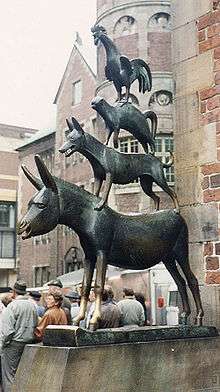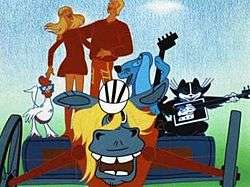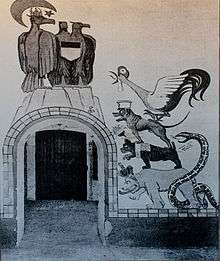Town Musicians of Bremen
| Town Musicians of Bremen | |
|---|---|
 A bronze statue by Gerhard Marcks depicting the Bremen Town Musicians located in Bremen, Germany. The statue was erected in 1953. Note the front hooves that have become shiny. Touching the front hooves is said to make wishes come true. | |
| Folk tale | |
| Name | Town Musicians of Bremen |
| Data | |
| Aarne-Thompson grouping | 130 |
| Country | Germany |
Coordinates: 53°04′34″N 8°48′27″E / 53.076181°N 8.807528°E
The "Town Musicians of Bremen" (German: Die Bremer Stadtmusikanten) is a popular fairy tale retrieved and recorded by the Brothers Grimm. It was first published in Grimms' Fairy Tales in 1819. It tells the story of four aging domestic animals, who after a lifetime of hard work are neglected and mistreated by their former masters. Eventually, they decide to run away and become town musicians in the city of Bremen. Contrary to the story's title the characters never arrive in Bremen, as they succeed in tricking and scaring off a band of robbers, capturing their spoils, and moving into their house. According to the Aarne–Thompson classification system, the story qualifies as a Type 130 folktale ("Outcast animals find a new home").[1]
Plot
In the story, a donkey, a dog, a cat, and a rooster (or hen), all past their prime years in life and usefulness on their respective farms, were soon to be discarded or mistreated by their masters. One by one, they leave their homes and set out together. They decide to go to Bremen, known for its freedom, to live without owners and become musicians there ("Something better than death we can find anywhere").
On the way to Bremen, they see a lighted cottage; they look inside and see four robbers enjoying their ill-gotten gains. Standing on each other's backs, they decide to scare the robbers away by making a din; the men run for their lives, not knowing what the strange sound is. The animals take possession of the house, eat a good meal, and settle in for the evening.
Later that night, the robbers return and send one of their members in to investigate. He sees the Cat's eyes shining in the darkness and the robber thinks he is seeing the coals of the fire. He reaches over to light his candle. Things happen in quick succession; the Cat scratches his face with her claws, the Dog bites him on the leg, the Donkey kicks him with his hooves, and the Rooster crows and chases him out the door, screaming. He tells his companions that he was beset by a horrible witch who scratched him with her long fingernails (the Cat), an man with a knife (the Dog), a black monster who had hit him with a club (the Donkey), and worst of all, the judge who screamed from the rooftop (the Rooster). The robbers abandon the cottage to the strange creatures who have taken it, where the animals live happily for the rest of their days.
In the original version of this story, which dates from the twelfth century, the robbers are a bear, lion, and wolf, all animals featured in heraldric devices. When the donkey and his friends arrive in Bremen, the townsfolk applaud them for having rid the district of the terrible beasts. An alternate version involves the animals' master(s) being deprived of his livelihood (because the thieves stole his money and/or destroyed his farm or mill) and having to send his animals away, unable to take care of them any further. After the animals dispatch the thieves, they take the ill-gotten gains back to their master so he can rebuild. Other versions involve at least one wild, non-livestock animal, such as a lizard, helping the domestic animals out in dispatching the thieves.[2]
Cultural legacy
The tale has been retold through animated pictures, motion pictures (often musicals), theatre plays and operas.
Screen and stage adaptations

- German-U.S. composer Richard Mohaupt created the opera Die Bremer Stadtmusikanten, which premiered in Bremen 1949.
- The tale was adapted in humorous fashion for the British children's series Wolves, Witches and Giants narrated by Spike Milligan, but with the action taking place in 'Brum' (short for Birmingham) rather than Bremen.
- In the Soviet Union, the story was loosely adapted into an animated musical in 1969 by Yuri Entin and Vasily Livanov at the studio Soyuzmultfilm, The Bremen Town Musicians. It was followed by a sequel called On the Trail of the Town Musicians of Bremen. In 2000, a second 56-minute sequel was made, called The New Bremen Musicians (Но́вые бре́менские, Novyye bremenskiye).[3]
- In 1976, in Italy, Sergio Bardotti and Luis Enríquez Bacalov adapted the story into a musical play called I Musicanti, which two years later was translated into Portuguese by the Brazilian composer Chico Buarque. The musical play was called Os Saltimbancos, was later released as an album, and became one of the greatest classics for children in Brazil. This version was also made into a movie.[4] In Spain, the story was made into an animated feature film, Los Trotamúsicos in 1989, directed by Cruz Delgado.[5] This in itself inspired the Spanish animated series Los Trotamúsicos. The series follows the story of four animal friends: Koki the rooster, Lupo the dog, Burlón the cat and Tonto the donkey; who form a band in the playing respectively guitar, drums, trumpet and saxophone. Unlike in the original story, they arrive to Bremen, before going back to live in the robbers' house.
- In 1972, Jim Henson produced a version with his Muppets called The Muppet Musicians of Bremen.
- In 1981 in Japan, Tezuka Productions made loose science fiction themed animated feature film adaptation titled Bremen 4: Angels in Hell (ブレーメン4 地獄の中の天使たち/Bremen 4: Jigoku no Naka no Tenshi-tachi)revolving around an Alien visiting Earth, during a military invasion of a fictional Bremen and giving the 4 animals based on the ones from the original tale, a device that can transform them in to humans. Despite being aimed at children the film has a substantial amount of gun violence and depictions of war crimes but its core theme is Anti-war.
- In Germany and the United States, the story was adapted into an animated feature in 1997 under the title The Fearless Four (Die furchtlosen Vier), though it varied considerably from the source material; while the general plot is the same, the four arrive in Bremen and help to free it from the grasp of the corrupt corporation Mix Max, along with rescuing animals that the company plans to turn into sausage. It starred R&B singer James Ingram as Buster the dog, guitarist B.B. King as Fred the donkey, singer and pianist Oleta Adams as Gwendolyn the cat and Italian musician Zucchero Fornaciari as Tortellini the Rooster in the original English version.
- On Cartoon Network in between cartoon breaks during the Out of Tune Toons marathon and on Cartoonetwork Video, there are cartoon shorts (called "Wedgies") of an animal garage band based on the tale called The Bremen Avenue Experience featuring a cat (Jessica), dog (Simon), donkey (Barret) and rooster (Tanner). They are either a modern adaptation of Town Musicians of Bremen or descendants of the old musicians of Bremen.
- The HBO Family animated series, Happily Ever After: Fairy Tales for Every Child, adapted this story in Season 3 and did a country/African-American twist on it featuring Jenifer Lewis as Hazel (the dog), Gladys Knight as Chocolate (the donkey), Dionne Warwick as Miss Kitty (the cat), and George Clinton as Scratchmo (the rooster).
Literature
- Richard Scarry wrote an adaptation of the story in his book Richard Scarry's Animal Nursery Tales in 1975. In it, the donkey, dog, cat and rooster set out since they are bored with farming.
- In the visual novel Morenatsu, the dog character Kouya is part of a rock band with three other performers: who are a cat, a bird, and a horse. The protagonist makes note of the resemblance to the Town Musicians of Bremen, with a brief monologue explaining the fairy tale.
- The fourth volume of the comic album series Blacksad a mystery unfolds in New Orleans around the remaining members of a defunct musical group formerly composed of a dog, a cat, a rooster, and a donkey, all of whom had migrated to the city from their home on a Southern island.
Music
- In the early 20th century, the American folk/swing/children's musician Frank Luther popularized the musical tale as the Raggletaggletown Singers,[6] presented in children's school music books and performed in children's plays.
- In 2015, Japanese rock musician Kenshi Yonezu released his third album titled Bremen, with the sixth track "Will-O-Wisp"'s lyrics being centred on the Town Musicians of Bremen.
- In 2012, American artists PigPen Theatre Co. released their debut album titled Bremen, with the fifth track "Bremen"'s lyrics telling the story of the Town Musicians of Bremen.
- The Musicians of Bremen (1972), based on the Brothers Grimm fairy tale, the "Town Musicians of Bremen", for male voices: two countertenors, tenor, two baritones and bass; premiered by The King's Singers in Sydney on 15 May 1972. A recording may be heard here: https://www.youtube.com/watch?v=C57Y7HtiUIE
Art and sculpture

- Statues modeled after the Town Musicians of Bremen statue now reside in front of each of the five German veterinary schools.
- A persiflage of this tale can be found on the wall in the Fort Napoleon, Ostend, Belgium. Heinrich-Otto Pieper, a German soldier during World War I, painted the German and the Austro-Hungarian eagles throned on a rock, under the light of a Turkish crescent. They look with contempt on the futile efforts of the Town Musicians of Bremen to chase them away. These animals are symbols for the Allied Forces: on top the French cock, standing on the Japanese jackal, standing on the English bulldog, standing on the Russian bear. Italy is depicted as a twisting snake and Belgium a tricolored beetle.
- A sculpture in Riga shows the animals breaking through a wall (symbolising the Iron Curtain).[7]
See also
- Joseph Jacobs cites this as a parallel version of the Irish Jack and His Comrades.
- Ub Iwerks' ComiColor Cartoon The Bremen Town Musicians (1935 film)
- The Bremen Town Musicians 1969 (Soviet musical cartoon)
- The Four harmonious animals is a figure in Jātaka tales and other Buddhist mythology
References
- ↑ "Tales Similar To Bremen Town Musicians". SurLaLune Fairy Tales. Retrieved February 10, 2018.
- ↑ "Die Bremer Stadtmusikanten / Bremen Town Musicians". German stories. Retrieved February 10, 2018.
- ↑ The New Bremen Musicians, Animator.ru
- ↑ https://www.imdb.com/title/tt0138073/
- ↑ "Los 4 músicos de Bremen (1989)". IMDb. Retrieved 2013-09-12.
- ↑ Sing Alone and like It Music, Charles L. Gary, Educators Journal April/May 1952 38: 48-49
- ↑ https://www.liveriga.com/en/3123-bremen-town-musicians
External links
| Wikisource has original text related to this article: |
| Wikimedia Commons has media related to Town musicians of Bremen. |
- SurLaLune's Annotated Bremen Town Musicians, including variants, modern interpretations and illustrations
- Full text of The Bremen Town Musicians from "The Fairy Book"
- Golden Books 1954 version
Some of the best known adaptations are:
- Town Musicians of Bremen on IMDb Disney 1922 animated version
- Town Musicians of Bremen on IMDb Russian animated version
- Town Musicians of Bremen on IMDb Brazilian musical free adaptation of the tale
- Town Musicians of Bremen on IMDb 1989 Spanish animated movie version
- Town Musicians of Bremen on IMDb 1997 German edition, also released in English under the title "The Fearless Four"
- Town Musicians of Bremen on IMDb The Muppet Musicians of Bremen
- The Disney version of The Four Musicians of Bremen at The Encyclopedia of Disney Animated Shorts
- Skulptures of the Musicians of Bremen, limited edition (German)
- Full text in side-by-side German and English at About.com